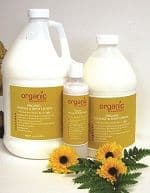

One of the most important decisions a massage therapist has to make with regard to the actual work is which type of lubricant is best for both the therapist and the client. There are so many things to take into consideration.
For example:
- Lotion, cream or oil? – The question as to which medium to use has a lot to do with how much glide is needed or wanted. Sometimes the technique used will dictate that. Heavier oils, such as olive oil, work best in low friction modalities, like Swedish massage. Lighter oils, such as grapeseed oil, absorb quickly and allow for more drag which is necessary for Sports massage and other techniques that focus on deep tissue massage. Lubricants that contain heavier oils will stay on the skin longer. This needs to be considered if someone is going back to work and may not want the oil to rub off on clothing. On the good side, staying on the surface of the skin longer also helps to keep it moisturized.
- Allergies – Some massage therapists like to use almond oil. It is a very good lubricant, until you have a client with nut allergies. This needs to be avoided; most hypo-allergenic oils and lotions will not have it as an ingredient. During intake, always note if there are allergies and make sure you have some alternative lubricants so as to avoid any adverse reactions.
- Effectiveness and therapeutic qualities – Anything put on the skin will have some effect. This is especially true when giving a massage. The lubricant used will not just be sitting on the surface of the skin, but it will be rubbed in and absorbed. It is important that anything used be helpful and not harmful to the client. Familiarize yourself with the ingredients of any substance used and their healing qualities.
Many massage therapists just continue to use whatever they used in massage school. Some schools use a variety of types and mediums, some stick to one they find best and cost effective. On the other hand, some schools may even ask students to bring in a lubricant of their own choosing. It is perhaps best to try several and see what works best for the techniques you use and your client base.
Some important ingredients to look for include:
- Aloe Vera – Contains over 200 active components including amino acids, enzymes, vitamins (A, C, E, folic acid, and B vitamins), minerals (calcium, magnesium, zinc, copper, manganese and more), and fatty acids. One of its properties is to help the body to adapt to external changes (like pollution). It helps in reducing the pain of burns as well as helping to heal damaged skin and increases the elasticity through collagen and elastic repair. Aloe is also an emollient; that is, it helps to soften and soothe the skin.
- Borage Oil – Contains gamma-linolenic acid, an important fatty acid that is thought to have an anti-inflammatory effect. It is often used to ease skin disorders like seborrheic dermatitis, eczema and neurodermatitis.
- Flaxseed Oil – Contains both omega-3 and omega-6 fatty acids. Flaxseed oil is know mostly for the benefits when used internally, cholesterol regulation, reduction of symptoms related to heart disease and reduction of ulcers caused by non-steroidal anti-inflammatory drugs. Externally it has been used to improve symptoms of psoriasis.
- Jojoba Oil – This oil is actually a liquid wax and has similar qualities to sebum, the oily, waxy substance the skin secretes which keeps hair and skin supple. Because of this quality it is easily absorbed and can help bring added nutrients to the skin. It can be used by itself as a massage oil, but is often combined with other ingredients for their added therapeutic qualities. Jojoba oil does not block the pores and has been used to treat acne. It has also been used to ease the symptoms of psoriasis, chapped skin and eczema.
- Shea Butter – Contains fatty acids, phytosterols and allantonin as well as vitamins E, D and A. It helps to protect your skin from UV sunlight and pollution. Shea butter also helps to keep skin hydrated and stimulates the production of collagen. It has been shown to help in the healing of eczema, psoriasis, skin cracking, burns and minor cuts. Like aloe, it helps to cool and soothe the skin.
- Vitamin E – Is a strong antioxidant that helps to prevent premature aging. It is often used to help reduce scarring from burns, surgery and old wounds. It is also thought to lighten brown spots on the skin.
When looking for an effective massage oil it may be important to find one that is all natural, that doesn’t use preservatives, artificial fragrances and made with ingredients that could be healthy both inside and out – that is, they could be eaten and not be toxic to your body.
Massage therapists already own the most important tool, their hands. The lubricant they choose to use comes in a close second. Choose wisely.
Editor’s Note: SAVE 15% on any Organic Bath & Body® order! Mention M-CREAM at checkout. Hurry! Ends 11/20/13.












One Response to Choosing Massage Lubricants Wisely